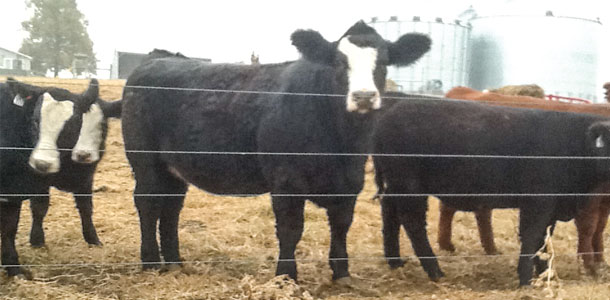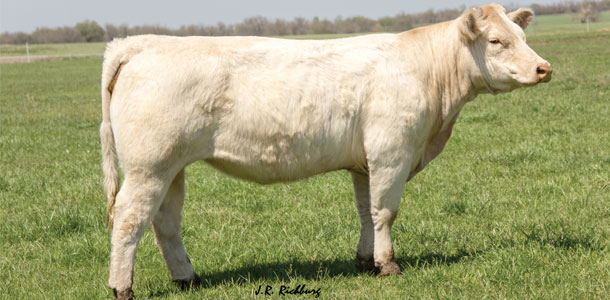Whatever your choice, somatic cell nuclear transfer, otherwise known as cloning technology can provide a way for a genetic legacy to live on. And that is exactly what some beef producers across the country are doing.
Recapturing the prize
Mark Mueller, owner of Diamond M Cattle Company in Hiawatha, Kansas, says his decision to clone his renowned cow, Blaze II 5T, was an easy one. After seven years of winning multiple livestock shows and accumulating close to $750,000 in embryo and live-calf sales, Mueller figured cloning could be a good investment.
“This particular cow has made us more money than any other cow on our operation,” Mueller says. “So preserving her genetics seemed like a good decision to me. This way, we can still have those genetics that took many years to build long after Blaze is gone.”
For nearly four decades, the Diamond M Cattle Company has run an intensive embryo program and has provided breeding stock to producers across the country.
In recent years, the Mueller family decided to incorporate a show calf segment to diversify their business. Because of the nature of their business, exceptional genetics is vital to their success.

So in the fall of 2012, Mueller’s first and only clone was born – charcoal black with a white-snipped face, unmistakably identical to the original.
Since then, the clone has been bred and is scheduled to calve this spring. Mueller says afterward he plans to flush her and embryo transfer her, just like he has done with the original cow. He is optimistic that her offspring will be just as good or better than the original.
“It is all about bettering our genetics,” Mueller says. “To go out and buy another female like the original cow is usually going to cost you as much or more than what the clone will. So why not be able to get the same genetics you know work and clone the one you have?”
Although Mueller is pleased with the results of his clone, he points out that cloning doesn’t come without risk. He says he started this cloning project with an industry partner to produce two clones; in the end Mueller’s clone was the only one that was born.
“You can get a lot of money wrapped up into cloning. The only reason I felt that it was feasible for my operation is because of the money Blaze had made over the years. I felt that I could invest some money into furthering our genetics,” he says.
A way to access high-profile genetics
Approximately 250 miles south of the Diamond M Cattle Company, in Galesburg, Kansas, resides Don Coover, a seedstock producer and owner of SEK Genetics.

Coover says outside of his semen distribution company, cloning technology has given him access to exceptional genetics he otherwise wouldn’t have been able to introduce into his own cattle operation.
“These cows that I cloned were high-profile cows that had a really good production history behind them,” Coover says. “I contacted the owners and asked them if they would let me clone their cows at no charge to them. But in return they would get half of the genetic interest in them."
"So in other words, I would make the clone, make the embryos, sell the embryos and split the profit with the owner, but I get to keep the cow.”
In accordance with his plan, Coover was able to add 10 clones to his cattle operation over the course of 15 years. He felt these particular cows justified the expense of cloning because they had already proven their worth and provided valuable genetics to the industry, he says.
This plan essentially provided Coover an opportunity to gain access to specific animals he otherwise wouldn’t have been able to afford if it wasn’t for his shared genetic ownership.
“I have always been interested in trying new technologies, so this plan was a good fit for me,” he says.
Coover strongly believes one day producers will use cloning just like any other technology. He says there is no reason to be afraid of cloning – it is an advanced reproductive technology similar to A.I., in vitro fertilization and embryo transfer. Right now, it is just dramatically inhibited because of the patent on the technology, he says.
If the technology becomes more efficient, and hopefully much cheaper, it will become more useful to the cattle industry, he says.
Developing new technology on a broad scale
For nearly a century, the J.R. Simplot Company has been taking promising technologies and implementing them into their varied programs. In fact, innovation is a large contributor to their renowned success, says Brady Hicks, a cattle research manager for Simplot.
With close to 30,000 head of cattle divided on 14 different ranches across the U.S., Simplot is known as one of the largest beef producers in the U.S. Among the many diversified segments of Simplot is a custom-feeding operation, heifer replacement program and two major feedlots which can hold a one-time capacity of 150,000 calves.
“When Mr. Simplot started this company, he was always trying something new, and that is what got us to this point,” Hicks says. “Cloning was later one of those things we decided to try, and it was an effective tool for many years.”
Hicks says for a few years they cloned cows both on the ranch and in the feedlots. They would look for certain characteristics in cattle that had just come off the desert range, such as longevity and good calf production.
The cows that lasted longer than the average life expectancy and were still producing quality cattle were good candidates for cloning, he says. They also used the same standards in their feedlots but looked for traits such as prime, yield grade 1.
“The technology in itself doesn’t produce the best animal; you have to find that animal, an animal that has all of the pieces in the right package,” Hicks says. “And then cloning technology just replicates it; it makes an identical twin separated in time.”
For Simplot, it was a matter of keeping the animals that had an economic value to them rather than replacing the old with a new line of heifers. The set of characteristics they are looking for is rare, and there is something about that animal that has been selected by its environment to withstand the frailties of old age, he says.
Simplot is currently still utilizing the clones and their genetics, but they are no longer actively cloning, Hicks says. Because of the current cattle prices, cloning is not economically feasible for their company unless it is an extreme animal that is right for production. However, when cattle prices drop, Hicks says they will probably start using cloning technology again.
In their opinion
Small scale or large scale, these three cattlemen believe this advanced reproductive technology can be a good investment if the animal is worth the expense. It also provides a way for producers to secure a cell line of an animal that is valuable but hasn’t quite proven its worth to the point of cloning.
This way, if something were to happen to the animal later on, it can still be cloned.
“This technology holds great promise to the future of the industry,” Coover says. “It is nothing to be afraid of. You’re producing a copy of something that was naturally produced; it is not too far from natural-occurring clones – which we call identical twins.”
Like any technology it has some risk, but according to these three cattlemen, it has been well worth the gamble. ![]()
Cassidy Woolsey is a freelance writer based in Utah.
PHOTOS
PHOTO 1: The original Blaze II 5T cow. Photo courtesy of Mark Mueller.
PHOTO 2: The clone of Blaze II 5T. Photo courtesy of Mark Mueller.
PHOTO 3: Boo is the clone of Phylli, the dam of Yellow Jacket and Polar Ice. Photo courtesy of Don Coover.








